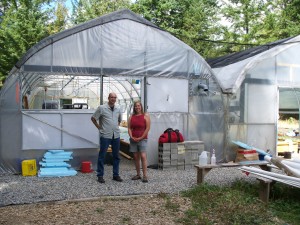When I went to the Mother Earth News Fair, representatives from Hope, British Columbia, were there to introduce folks to their area. I entered their contest for two nights at a B&B in Hope, B.C. and, unbelievably, I won. (I know! How odd.) So, I made a reservation, commandeered The Sister, and we were off.
We stayed at the High Hopes Bed and Breakfast which I cannot recommend highly enough. It is perched above the river valley with amazing views of the mountains. All the rooms are incredibly well appointed, with an additional lounge area for guests. My favorite things about this B&B include:
- The beds were really comfortable.
- Our host, Pauline, brought me coffee and a muffin first thing in the morning, even before breakfast. Oh, and the breakfasts are very yummy.
- The view at night from my balcony (every room has one) was stunning, with dense stars surrounded by a ring of mountains.
Hope is quite a lovely town. It’s on a bend of the Fraser River with a long park along the river and a city block-sized park in the middle of town. It’s surrounded by high mountains, clear lakes, and lots of wilderness. We walked around town and decided to stop at an Indian restaurant we saw, called Sakoon. I was not expecting such good food and I was quite pleasantly surprised at all the rich flavors. I’ll go back…even if it is several hours away from home.
The one thing I was really happy to see was the Hope Cinema, which recently installed a new digital projector, ensuring that they can show first-run films for years to come. It’s huge financial burden to change projectors and they are asking for donations to help defray the costs. So many towns across North America are losing their theaters to this crushing requirement by film distributors that all theaters must have digital projectors or they won’t receive any new films to show. Most small towns can’t support the cost of a new projector ($30,000 to $200,000 per theater) and the owners can’t keep a theater viable without films to show. Most of them are simply closing. We watched Elysium in Hope Cinema’s surprisingly large space. (It holds 320 people.) It was a great experience.
We then went to the Blue Moose Coffee House and had a nice cup of chai. Mmmm…yummy!
I love taking road trips. I’ve driven all over North America in my lifetime, meeting new people and experiencing the countryside. As, I was touring the Fraser River Valley, visiting farms and taking in the sites. I was quite impressed with the amount of land that was under cultivation in the river valley and the updated farm equipment and buildings I saw everywhere. There weren’t any abandoned farms. There weren’t any barns falling down or fields untended. The local farming community was well supported and farmers markets and agri-tourism were everywhere.
As I drove back across the border, into the U.S., the change was quite evident. More farmers here are struggling. More farms lay fallow, with fields turning back to a scruffy kind of wildness. It’s harder to find farm tours or to buy directly from a farm unless you know where to look. A collapsing barn is more the standard than the exception. Even in Skagit Valley, where the emphasis is strongly on agriculture, there are farms around every corner of Highway 9 that lay fallow.
Perhaps it’s because Canada didn’t suffer the recession we did here, or maybe it’s the Canadian government’s emphasis on agriculture that has made the difference. Maybe the University of British Columbia’s Land and Food System programs, including dairy, viniculture, and permaculture, are making the difference. Perhaps it’s all of these things together.
No matter what programs are in place, it’s ultimately up to us to determine how we want our food grown and consumed. Compared to the mighty Fraser River, the Stillaguamish may be small. However, it’s our corner of the world and we determine how we move forward here. Taking steps, such as the Port Susan Farmers Market is a good start. It is only a start, though, with much left to do.
Our farmers are retiring and we need young farmers, well trained ones at that, to take their place. How do we attract them? How do we get existing farmers to stay on the land and get new farmers to move here? We do it through vibrant local and regional markets, through vital support systems, and through our strong appreciation of what they bring to our community. We can provide the economic basis for a lasting farming community if it’s within our willpower to do so. Ultimately, it’s really up to us.

